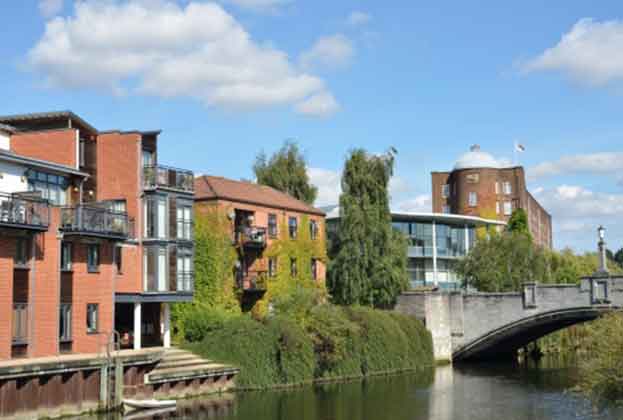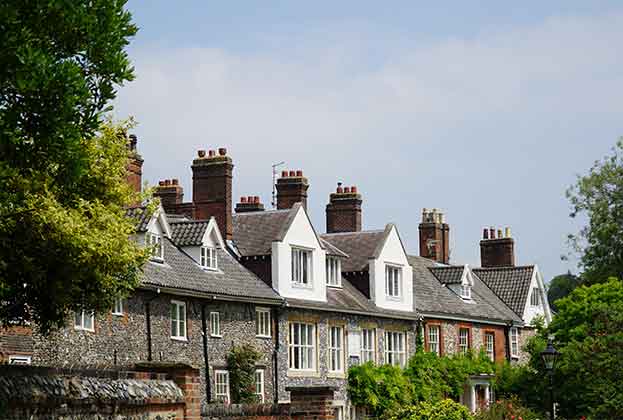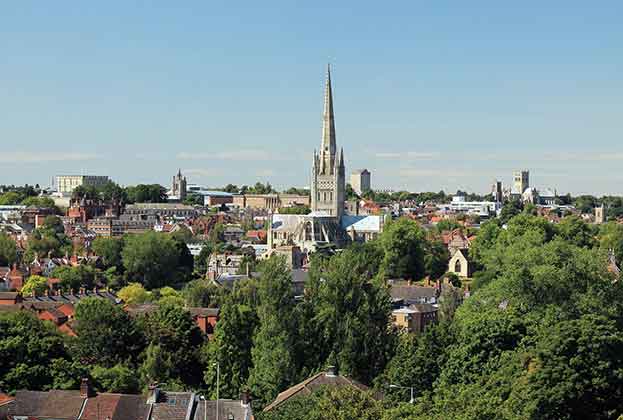Norfolk has something for everyone, with county capital Norwich being one of the fastest-growing cities in the UK
Broad appeal
Norfolk enjoys over 90 miles of unspoilt coastline, beautiful countryside, the unique Broads National Park, forests, heathland, internationally important nature reserves, picturesque market towns, and fabulous seaside resorts. However, with so many benefits deriving from its remoteness, the county must act to ensure its strengths in research and technology are perceived as world-class, with a clear strategy to continue improvements in transport and infrastructure.
Norfolk is one of the UK’s most popular tourist destinations, with tourism contributing £3 billion to its economy last year. Norwich has also been voted one of the “Best Places to Live in The UK” in 2018 and 2019, with its Upper St Giles Street area named among the “30 Coolest Places to Live in Britain”. The city’s cultural scene has a strong pull for young people and it maintains its top 20 status in PwC’s Good Growth for Cities Index, ranking above Manchester, Birmingham and Newcastle. Norwich also boasts the winner of the 2019 Stirling Prize, the first time the prize has been awarded to social housing. It is hardly surprising that so many people choose Norfolk as a place to live and work.

A growing city
Norwich is one of the fastest-growing cities in the UK; since 2000 the population has increased at a stronger rate than for the UK as a whole. Norwich has a higher than average prime working-age population (ages 18–49) and smaller household sizes, meaning that the number of homes required is likely to continue increasing. A younger population brings advantages attracting businesses, who can draw from a larger pool of working-age residents. However, cities need to provide opportunities for young people to start and build careers, as well as cultural amenities, schools and affordable housing.
Norwich has a strong local economy: the city is home to more than 123,000 jobs and more than 8,000 businesses, both local and international. Some larger corporate occupiers have consolidated in the last few years, yet a significant number remain committed to the city including Aviva, Marsh, Swiss Re Life & Health and Alan Boswell Group.
The University of East Anglia retains over 40% of its graduates, creating a strong local talent pool
Savills Research
The city is home to two leading universities and several research institutes, which promote a highly skilled workforce and are crucial to the strong development of the city’s tech and digital creative sectors. The University of East Anglia (UEA) is consistently ranked in the top 15 of UK university league tables and retains over 40% of its graduates, contributing a strong ‘talent pool’ within the city. Norwich University of the Arts has been shortlisted twice for this year’s Times Higher Education Awards and is a finalist in the Outstanding Student Support category, as a UK institution that “helps students to gain the maximum benefit from their study”.
Leveraging Innovation
The region is home to companies that are shaping the future of food, energy, medicine and mobility. Norwich Research Park offers a supportive and collaborative community of 115 companies, 12,000 employees and 3,000 scientists, researchers and clinicians. The Park’s John Innes Centre, an international centre of excellence in plant science and microbiology, won the BBSRC’s 2013–2016 Excellence With Impact Award. The Norfolk and Norwich University Hospital (NNUH) is the teaching hospital for health professionals studying at the UEA. NNUH has an R&D department which supports the development, approval and running of research projects.
The tech and creative sectors are expected to see employment growth of 11.3% between 2019 and 2024, resulting in over 1,000 extra jobs in these sectors
Savills Research
Norwich is also part of the ‘Tech Corridor’ investment initiative, connecting Norwich and Cambridge along the A11, recognising these two areas as key technology hubs, aiming to create £500m of innovation-led growth, infrastructure and housing. The tech and creative sectors are expected to see employment growth of 11.3% between 2019 and 2024, resulting in over 1,000 extra jobs in these sectors.
Positive growth of any local economy will be supported by the growth of its startups. Between 2011–2016, digital employment in the city grew by around 40% and the stock of digital businesses by around 30%, which is substantially faster than the growth in the Norwich economy overall. Creative and digital companies are at the forefront of flexible-workspace growth and Norwich is now beginning to react with developments such as St George’s Works and the Fuel Studios accommodating the needs of these growing companies.
Nurturing a strong retail presence
In contrast with many other locations, Norwich has a strong retail offer, boasting the largest permanent undercover market in Europe. Savills review of cities across the country found that Norwich ranks as 12th most Resilient Retail Destination.
However, the historic infrastructure means that a lot of the retail units are unfit for modern retail use. The smaller boutiques of the Lanes are attractive to tourists, but do not meet all the needs of the local shoppers. The larger units lie to the west of the castle. The development of Chapelfield Shopping Centre in 2005 pulled the main retail area further south. Primark has dealt with store size issues by incorporating the adjacent unit via a large scale redevelopment, due to complete by Christmas 2019. Department stores in the city centre include Debenhams, John Lewis, Marks & Spencer, House of Fraser and Jarrolds. The multiples lie to the south, but Jarrolds, the only independent store is an icon of the historic centre.
Norwich needs to consider how it adapts its space in the future and reduces its exposure to vacant space. Looking ahead, property repurposing will be a key theme for Norwich. A new mix of uses plays a crucial role in diversifying land use and generating footfall both during and after business hours, which in turn helps the retail and leisure sectors.
Expanding the city eastwards
The city has so much to offer both tourists and its local workforce but it will be left behind if it cannot improve east-west links and regenerate the southeast quarter of the city. The scale of opportunity presented by the soon to be redundant manufacturing plant at Carrow Works and the adjacent former industrial site at the Deal Ground and Utilities Sites cannot be overstated.
Norwich was recently awarded £6.1 million to improve public transport and sustainability in selected areas of the city
Savills Research
By 2030, the city hopes to create a dense low-car quarter towards the south-east of the city with cutting-edge sustainable urban transport which will help to ensure the best talent stays in the city and generate good quality sustained investment in people and jobs. This new quarter could provide up to 4,000 houses and 100,000 sq ft of commercial space, accommodating up to 6,000 jobs. To enable this vision some key investment in infrastructure is required.
Norwich has frequent direct services to London Liverpool Street and quick access to key regional hubs Peterborough and Cambridge. It also benefits from its own international airport. Norwich was recently awarded £6.1 million by the Department of Transport as part of the Transforming Cities Scheme to improve public transport and sustainability in selected areas of the city.
The A11 to Cambridge was widened in 2014, strengthening the link between the two cities and supporting the tech corridor between them. The A47 was also identified as infrastructure in need of improvement in the Government’s Road Investment Strategy in 2014. Upgrades are planned for six hotspots along the route, including the Thickthorn junction; work is due to start in 2021 with completion timetabled for 2023.
Read the articles within Norfolk and Norwich: Adapting for change below.
.jpg)




